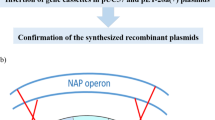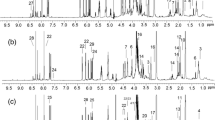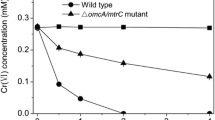Abstract
In recent years, bioremediation is considered as an efficient method to remove the pollutants from the industrial wastewater. In this study, quantitative gene expressions (Real-time RT-PCR) of mtr gene cluster (mtrA, mtrB, mtrC, mtrD, mtrE, mtrF and omcA) in five different uranium concentrations (0.1, 0.25, 0.5, 1 and 2 mM) were performed with ICP and microscopic live cell counting analysis under anaerobic condition, by Shewanella RCRI7 as a native bacterium. The results indicated that the amount of uranium removal and live-cell counting were decreased in the higher uranium concentrations (1 and 2 mM), due to the uranium toxicity, suggesting 0.5 mM as the optimum uranium concentration for Shewanella RCRI7 resistance. The expression of mtrCED and omcA genes presented increasing trend in the lower uranium concentrations (0.1, 0.25 and 0.5 mM) and a decreasing trend in 1 and 2 mM, while mtrABF, presented an inverse pattern, proving the alternative role of mtrF for mtrC and omcA, as the substantial multiheme cytochromes in Extracellular Electron Transfer (EET) pathway. These data are a proof of these gene vital roles in the EET pathway, proposing them for genetic engineering toward EET optimization, as the certain pathway in heavy metal bioremediation process.










Similar content being viewed by others
References
Babij T, Madgwick JC (1993) High yield bacterial leaching of copper concentrate. In Proc Aust Inst Min Met, PP 61–64
Barchinger SE et al (2016) Regulation of gene expression during electron acceptor limitation and bacterial nanowire formation in Shewanella oneidensis MR-1. Appl Environ Microbiol AEM 1:01615–01616
Beliaev AS, Saffarini DA (1998) Shewanella putrefaciens mtrB encodes an outer membrane protein required for Fe (III) and Mn (IV) reduction. J Bacteriol 180:6292–6297
Beliaev AS, Saffarini DA, McLaughlin JL, Hunnicutt D (2001) MtrC, an outer membrane decahaem c cytochrome required for metal reduction in Shewanella putrefaciens MR-1. Mol Microbiol 39:722–730
Bretschger O et al (2007) Current production and metal oxide reduction by Shewanella oneidensis MR-1 wild type and mutants. Appl Environ Microbiol 73:7003–7012
Brown SD et al (2006) Cellular response of Shewanella oneidensis to strontium stress. Appl Environ Microbiol 72:890–900
Bücking C, Popp F, Kerzenmacher S, Gescher J (2010) Involvement and specificity of Shewanella oneidensis outer membrane cytochromes in the reduction of soluble and solid-phase terminal electron acceptors. FEMS Microbiol Lett 306:144–151
Burgos WD et al (2008) Characterization of uraninite nanoparticles produced by Shewanella oneidensis MR-1. Geochim Cosmochim Acta 72:4901–4915
Coursolle D, Gralnick JA (2010) Modularity of the Mtr respiratory pathway of Shewanella oneidensis strain MR-1. Mol Microbiol 77:995–1008
Czerwinski KR, Polz MF (2008) Uranium enrichment using microorganisms. Google Patents, India
Espinosa-Soto C, Wagner A (2010) Specialization can drive the evolution of modularity. PLoS Comput Biol 6:e1000719
Gorby YA et al (2006) Electrically conductive bacterial nanowires produced by Shewanella oneidensis strain MR-1 and other microorganisms. Proc Natl Acad Sci 103:11358–11363
Haas JR, Northup A (2004) Effects of aqueous complexation on reductive precipitation of uranium by Shewanella putrefaciens. Geochem Trans 5:41
Harris HW, El-Naggar MY, Nealson KH (2012) Shewanella oneidensis MR-1 chemotaxis proteins and electron-transport chain components essential for congregation near insoluble electron acceptors. Portland Press Limited, Portland
Haveman SA, Greene EA, Stilwell CP, Voordouw JK, Voordouw G (2004) Physiological and gene expression analysis of inhibition of Desulfovibrio vulgaris Hildenborough by nitrite. J Bacteriol 186:7944–7950
He Q et al (2006) Energetic consequences of nitrite stress in Desulfovibrio vulgaris Hildenborough, inferred from global transcriptional analysis. Appl Environ Microbiol 72:4370–4381
Hungate R (1969) A roll tube method for cultivation of strict anaerobes. Methods in microbiology, Elsevier
Hyun B (2003) Flow Cytometry Instrumentation. Curr Prot Cytomet 26:10
Jiang X et al (2019) Kinetics of trifurcated electron flow in the decaheme bacterial proteins MtrC and MtrF. Proc Natl Acad Sci 116:3425–3430
Jin M et al (2013) Unique organizational and functional features of the cytochrome c maturation system in Shewanella oneidensis. PLoS ONE 8:e75610
Kasai T, Kouzuma A, Nojiri H, Watanabe K (2015) Transcriptional mechanisms for differential expression of outer membrane cytochrome genes omcA and mtrC in Shewanella oneidensis MR-1. BMC Microbiol 15:1
Kouzuma A, Kasai T, Hirose A, Watanabe K (2015) Catabolic and regulatory systems in Shewanella oneidensis MR-1 involved in electricity generation in microbial fuel cells. Front Microbiol 6:609
Li D-B et al (2014) Selenite reduction by Shewanella oneidensis MR-1 is mediated by fumarate reductase in periplasm. Sci Rep 4:7
Lovley DR, Phillips EJ, Gorby YA, Landa ER (1991) Microbial reduction of uranium. Nature 350:413
Mahadevan R, Palsson B, Lovley DR (2011) In situ to in silico and back: elucidating the physiology and ecology of Geobacter spp using genome-scale modelling. Nat Rev Microbiol 9:39
Marshall MJ et al (2006) c-Type cytochrome-dependent formation of U (IV) nanoparticles by Shewanella oneidensis. PLoS Biol 4:e268
McLean JS et al (2008) Oxygen-dependent autoaggregation in Shewanella oneidensis MR-1. Environ Microbiol 10:1861–1876
Mullen LM (2007) Bacterial influence on uranium oxidation reduction reactions: implications for environmental remediation and isotopic composition. Massachusetts Institute of Technology, Massachusetts
Myers C, Carstens B, Antholine W, Myers J (2000) Chromium (VI) reductase activity is associated with the cytoplasmic membrane of anaerobically grown Shewanella putrefaciens MR-1. J Appl Microbiol 88:98–106
O'neil RA et al (2008) Gene transcript analysis of assimilatory iron limitation in Geobacteraceae during groundwater bioremediation. Environ Microbiol 10:1218–1230
Orellana R et al (2013) U (VI) reduction by a diversity of outer surface c-type cytochromes of Geobacter sulfurreducens. AEM Appl Environ Microbiol 1:2551–2573
Paquete CM et al (2014) Exploring the molecular mechanisms of electron shuttling across the microbe/metal space. Front Microbiol 5:318
Pirbadian S et al (2014) Shewanella oneidensis MR-1 nanowires are outer membrane and periplasmic extensions of the extracellular electron transport components. Proc Natl Acad Sci 111:12883–12888
Rossi G (1990) Biohydrometallurgy. McGraw-Hill, New york
Saffarini D, Brockman K, Beliaev A, Bouhenni R, Shirodkar S (2015) Shewanella oneidensis and extracellular electron transfer to metal oxides. Springer, London.
Saffarini DA, Schultz R, Beliaev A (2003) Involvement of cyclic AMP (cAMP) and cAMP receptor protein in anaerobic respiration of Shewanella oneidensis. J Bacteriol 185:3668–3671
Schuetz B, Schicklberger M, Kuermann J, Spormann AM, Gescher J (2009) Periplasmic electron transfer via the c-type cytochromes MtrA and FccA of Shewanella oneidensis MR-1. Appl Environ Microbiol 75:7789–7796
Seyrig G (2010) Uranium bioremediation: current knowledge and trends. Basic Biotechnol 6:19
Shi L, Squier TC, Zachara JM, Fredrickson JK (2007) Respiration of metal (hydr) oxides by Shewanella and Geobacter: a key role for multihaem c-type cytochromes. Mol Microbiol 65:12–20
Tarhriz V et al (2014) Isolation and characterization of naphtalene-degradation bacteria from Qurugol lake located at Azerbaijan. Biosci Biotechnol Res Asia 11:715–722
Tapia-Rodríguez A, Luna-Velasco A, Field JA, Sierra-Alvarez R (2012) Toxicity of uranium to microbial communities in anaerobic biofilms. Water Air Soil Pollut 223:3859–3868
TerAvest MA (2014) Biological limitations of Shewanella oneidensis MR-1 in bioelectrochemical systems. Cornell University, Cornell
Thorgersen MP et al (2017) A highly expressed high-molecular-weight S-layer complex of Pelosinus sp. strain UFO1 binds uranium. Appl Environ Microbiol 83:e03044–e3076
Wall JD, Krumholz LR (2006) Uranium reduction. Annu Rev Microbiol 60:149–166
Wan X-F et al (2004) Transcriptomic and proteomic characterization of the Fur modulon in the metal-reducing bacterium Shewanella oneidensis. J Bacteriol 186:8385–8400
Yarzabal A, Appia-Ayme C, Ratouchniak J, Bonnefoy V (2004) Regulation of the expression of the Acidithiobacillus ferrooxidans rus operon encoding two cytochromes c, a cytochrome oxidase and rusticyanin. Microbiology 150:2113–2123
Yarzábal A, Duquesne K, Bonnefoy V (2003) Rusticyanin gene expression of Acidithiobacillus ferrooxidans ATCC 33020 in sulfur-and in ferrous iron media. Hydrometallurgy 71:107–114
Zaheri Abdehvand A, Keshtkar A, Fatemi F, Tarhriz V, Hejazi MS (2017) Removal of U (VI) from aqueous solutions using Shewanella sp. RCRI7, isolated from Qurugöl Lake in Iran. Radiochim Acta 105:109–120
Acknowledgements
The isolate was kindly provided by V. Tarhriz and M.S, Hejazi from Tabriz University of Medical Sciences, Tabriz, Iran.
Author information
Authors and Affiliations
Corresponding authors
Additional information
Communicated by Erko Stackebrandt.
Publisher's Note
Springer Nature remains neutral with regard to jurisdictional claims in published maps and institutional affiliations.
Rights and permissions
About this article
Cite this article
Ghasemi, R., Fatemi, F., Mir-Derikvand, M. et al. Evaluation of mtr cluster expression in Shewanella RCRI7 during uranium removal. Arch Microbiol 202, 2711–2726 (2020). https://doi.org/10.1007/s00203-020-01981-1
Received:
Revised:
Accepted:
Published:
Issue Date:
DOI: https://doi.org/10.1007/s00203-020-01981-1






